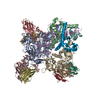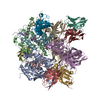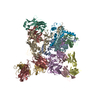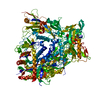+ Open data
Open data
- Basic information
Basic information
| Entry | Database: PDB / ID: 8vh2 | |||||||||||||||
|---|---|---|---|---|---|---|---|---|---|---|---|---|---|---|---|---|
| Title | CH235.12 Fab bound to the HIV-1 CH505.M5 SOSIP | |||||||||||||||
 Components Components |
| |||||||||||||||
 Keywords Keywords | VIRAL PROTEIN/IMMUNE SYSTEM / Immunogen / Vaccine / Antibody / VIRAL PROTEIN / VIRAL PROTEIN-IMMUNE SYSTEM complex | |||||||||||||||
| Function / homology |  Function and homology information Function and homology informationsymbiont-mediated perturbation of host defense response / positive regulation of plasma membrane raft polarization / positive regulation of receptor clustering / host cell endosome membrane / clathrin-dependent endocytosis of virus by host cell / viral protein processing / fusion of virus membrane with host plasma membrane / fusion of virus membrane with host endosome membrane / viral envelope / virion attachment to host cell ...symbiont-mediated perturbation of host defense response / positive regulation of plasma membrane raft polarization / positive regulation of receptor clustering / host cell endosome membrane / clathrin-dependent endocytosis of virus by host cell / viral protein processing / fusion of virus membrane with host plasma membrane / fusion of virus membrane with host endosome membrane / viral envelope / virion attachment to host cell / host cell plasma membrane / virion membrane / structural molecule activity / membrane Similarity search - Function | |||||||||||||||
| Biological species |   Human immunodeficiency virus 1 Human immunodeficiency virus 1 Homo sapiens (human) Homo sapiens (human) | |||||||||||||||
| Method | ELECTRON MICROSCOPY / single particle reconstruction / cryo EM / Resolution: 4.31 Å | |||||||||||||||
 Authors Authors | Henderson, R. / Acharya, P. | |||||||||||||||
| Funding support |  United States, 4items United States, 4items
| |||||||||||||||
 Citation Citation |  Journal: Nat Commun / Year: 2024 Journal: Nat Commun / Year: 2024Title: Engineering immunogens that select for specific mutations in HIV broadly neutralizing antibodies. Authors: Rory Henderson / Kara Anasti / Kartik Manne / Victoria Stalls / Carrie Saunders / Yishak Bililign / Ashliegh Williams / Pimthada Bubphamala / Maya Montani / Sangita Kachhap / Jingjing Li / ...Authors: Rory Henderson / Kara Anasti / Kartik Manne / Victoria Stalls / Carrie Saunders / Yishak Bililign / Ashliegh Williams / Pimthada Bubphamala / Maya Montani / Sangita Kachhap / Jingjing Li / Chuancang Jaing / Amanda Newman / Derek W Cain / Xiaozhi Lu / Sravani Venkatayogi / Madison Berry / Kshitij Wagh / Bette Korber / Kevin O Saunders / Ming Tian / Fred Alt / Kevin Wiehe / Priyamvada Acharya / S Munir Alam / Barton F Haynes /  Abstract: Vaccine development targeting rapidly evolving pathogens such as HIV-1 requires induction of broadly neutralizing antibodies (bnAbs) with conserved paratopes and mutations, and in some cases, the ...Vaccine development targeting rapidly evolving pathogens such as HIV-1 requires induction of broadly neutralizing antibodies (bnAbs) with conserved paratopes and mutations, and in some cases, the same Ig-heavy chains. The current trial-and-error search for immunogen modifications that improve selection for specific bnAb mutations is imprecise. Here, to precisely engineer bnAb boosting immunogens, we use molecular dynamics simulations to examine encounter states that form when antibodies collide with the HIV-1 Envelope (Env). By mapping how bnAbs use encounter states to find their bound states, we identify Env mutations predicted to select for specific antibody mutations in two HIV-1 bnAb B cell lineages. The Env mutations encode antibody affinity gains and select for desired antibody mutations in vivo. These results demonstrate proof-of-concept that Env immunogens can be designed to directly select for specific antibody mutations at residue-level precision by vaccination, thus demonstrating the feasibility of sequential bnAb-inducing HIV-1 vaccine design. | |||||||||||||||
| History |
|
- Structure visualization
Structure visualization
| Structure viewer | Molecule:  Molmil Molmil Jmol/JSmol Jmol/JSmol |
|---|
- Downloads & links
Downloads & links
- Download
Download
| PDBx/mmCIF format |  8vh2.cif.gz 8vh2.cif.gz | 1012.2 KB | Display |  PDBx/mmCIF format PDBx/mmCIF format |
|---|---|---|---|---|
| PDB format |  pdb8vh2.ent.gz pdb8vh2.ent.gz | Display |  PDB format PDB format | |
| PDBx/mmJSON format |  8vh2.json.gz 8vh2.json.gz | Tree view |  PDBx/mmJSON format PDBx/mmJSON format | |
| Others |  Other downloads Other downloads |
-Validation report
| Summary document |  8vh2_validation.pdf.gz 8vh2_validation.pdf.gz | 1.2 MB | Display |  wwPDB validaton report wwPDB validaton report |
|---|---|---|---|---|
| Full document |  8vh2_full_validation.pdf.gz 8vh2_full_validation.pdf.gz | 1.2 MB | Display | |
| Data in XML |  8vh2_validation.xml.gz 8vh2_validation.xml.gz | 84.2 KB | Display | |
| Data in CIF |  8vh2_validation.cif.gz 8vh2_validation.cif.gz | 125.9 KB | Display | |
| Arichive directory |  https://data.pdbj.org/pub/pdb/validation_reports/vh/8vh2 https://data.pdbj.org/pub/pdb/validation_reports/vh/8vh2 ftp://data.pdbj.org/pub/pdb/validation_reports/vh/8vh2 ftp://data.pdbj.org/pub/pdb/validation_reports/vh/8vh2 | HTTPS FTP |
-Related structure data
| Related structure data |  43232MC  8vgvC  8vgwC  8vh1C  8vh3C M: map data used to model this data C: citing same article ( |
|---|---|
| Similar structure data | Similarity search - Function & homology  F&H Search F&H Search |
- Links
Links
- Assembly
Assembly
| Deposited unit | 
|
|---|---|
| 1 |
|
- Components
Components
| #1: Protein | Mass: 52246.586 Da / Num. of mol.: 3 Source method: isolated from a genetically manipulated source Source: (gene. exp.)   Human immunodeficiency virus 1 / Gene: env / Production host: Human immunodeficiency virus 1 / Gene: env / Production host:  Homo sapiens (human) / References: UniProt: M4M5H1 Homo sapiens (human) / References: UniProt: M4M5H1#2: Protein | Mass: 18089.646 Da / Num. of mol.: 3 Source method: isolated from a genetically manipulated source Source: (gene. exp.)   Human immunodeficiency virus 1 / Gene: env / Production host: Human immunodeficiency virus 1 / Gene: env / Production host:  Homo sapiens (human) / References: UniProt: M4M5H1 Homo sapiens (human) / References: UniProt: M4M5H1#3: Antibody | Mass: 24319.373 Da / Num. of mol.: 3 Source method: isolated from a genetically manipulated source Source: (gene. exp.)  Homo sapiens (human) / Production host: Homo sapiens (human) / Production host:  Homo sapiens (human) Homo sapiens (human)#4: Antibody | Mass: 23450.996 Da / Num. of mol.: 3 Source method: isolated from a genetically manipulated source Source: (gene. exp.)  Homo sapiens (human) / Production host: Homo sapiens (human) / Production host:  Homo sapiens (human) Homo sapiens (human)Has protein modification | Y | |
|---|
-Experimental details
-Experiment
| Experiment | Method: ELECTRON MICROSCOPY |
|---|---|
| EM experiment | Aggregation state: PARTICLE / 3D reconstruction method: single particle reconstruction |
- Sample preparation
Sample preparation
| Component | Name: Antibody Fab bound HIV-1 ectodomain / Type: COMPLEX / Entity ID: all / Source: MULTIPLE SOURCES |
|---|---|
| Source (natural) | Organism:   Human immunodeficiency virus 1 Human immunodeficiency virus 1 |
| Source (recombinant) | Organism:  Homo sapiens (human) Homo sapiens (human) |
| Details of virus | Isolate: OTHER / Type: VIRION |
| Buffer solution | pH: 7.1 |
| Specimen | Embedding applied: NO / Shadowing applied: NO / Staining applied: NO / Vitrification applied: YES |
| Vitrification | Cryogen name: ETHANE |
- Electron microscopy imaging
Electron microscopy imaging
| Experimental equipment |  Model: Titan Krios / Image courtesy: FEI Company |
|---|---|
| Microscopy | Model: FEI TITAN KRIOS |
| Electron gun | Electron source:  FIELD EMISSION GUN / Accelerating voltage: 300 kV / Illumination mode: FLOOD BEAM FIELD EMISSION GUN / Accelerating voltage: 300 kV / Illumination mode: FLOOD BEAM |
| Electron lens | Mode: BRIGHT FIELD / Nominal defocus max: 3400 nm / Nominal defocus min: 100 nm |
| Image recording | Electron dose: 59.7 e/Å2 / Film or detector model: GATAN K3 (6k x 4k) |
- Processing
Processing
| CTF correction | Type: PHASE FLIPPING AND AMPLITUDE CORRECTION |
|---|---|
| 3D reconstruction | Resolution: 4.31 Å / Resolution method: FSC 0.143 CUT-OFF / Num. of particles: 148858 / Symmetry type: POINT |
 Movie
Movie Controller
Controller







 PDBj
PDBj





